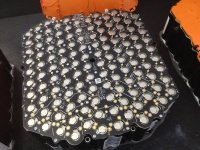I received several private messages during the last month about the project status and I think it is time to share some details.
First, I had to create my own battery modules for testing my BMS slave boards. I have been able to fit 120 x 18650 cells 12S10P in a 3Dprinted plastic case with Fire retardant ABS filament on my prusa MKII which gives me around 44.4V/module 50.4V when fully charged with approx. 1.5kWh capacity/module. I wanted a battery pack that is integrated with my ENNOID-BMS slave board and I ended up with battery modules that can be connected in parallel & series with other modules with quick connectors and minimal effort. For assembling the modules, all cells connections are done from one side & signals for cells voltages & temperatures sensors are routed toward the Slave BMS through the top PCB. This allows bottom cooling plate. For communication with others modules & master BMS board, only a twisted wire pair cable connection is required. I tested so far with 4 modules in series which is approx 200V.
Here is a rendering I made which shows the battery module concept with integrated Ennoid-BMS slave:

Here is a picture of a single battery module after putting the cells into the platic case (prototype without top handle):
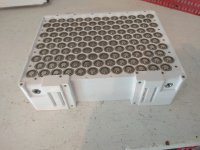
With ENNOID-BMS slave board sitting at the front before cell connection & without top cover:
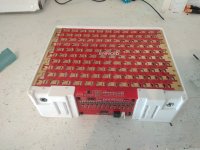
Once completed:

Slave-BMS assembly:

Here is the wiring diagram of the actual test bench:
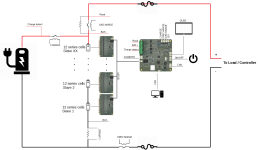
And finally the bench test with only one module that I later connected to a VESC 6 & small BLDC. It works! (the end goal is not to spin a small BLDC but a several KW motor):
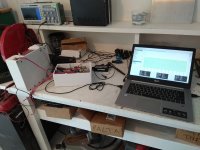
Here is a screenshot of ENNOID-BMS tool with 2 modules in series 24S approx. 100V:

So far everything works except the 8 temperature reading/modules when several modules are connected together (driver for the ADC128 is still in the work). Small adjustment are still needed for current & voltage sensing, but overall I'm satisfied.
The operation of the whole BMS is now possible:
- Charging
- Balancing
- Temperature monitoring ( Still some issues with ADC128 but slave & master temp monitoring are working)
- Voltages monitoring for load & pack
- Current monitoring for charge & discharge
- Cells voltages monitoring with single or several modules in series
-Precharge, discharge, charge with EV200 type contactors, up to 500A continuous
- several protections (over-voltage, under-voltage, over-temp, under-temp, over-current etc.)
- BMS tool and adjustable parameters (everything is working, but the interface will be simplified for Ennoid-BMS (DiebieMS HiAmp shield parameters not needed.
I will also create a small video in the future, which should explain all the details of the BMS & associated Battery pack & "Penthouse box".
The goal of the penthouse box is to create an easy plug & play setup for ENNOID-BMS. It has all the stuff packed inside for a complete ENNOID-BMS. It contains master BMS board with contactors, current sensor, power cabling, output & input cables & 12V 5A power supply .
Here is the wiring diagram for a complete system with the "penthouse box" & ENNOID modules :
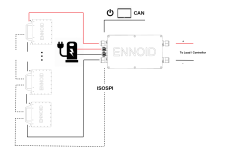
I will soon start to sell standalone assembled BMS board, "penthouse boxes" & battery modules on my website for the ones interested.
On my side, I'm planning to build an atv equipped with my penthouse box & my battery modules.
Of course, the whole thing is open source!











